Barriers Rankings #1: Albuquerque, NM
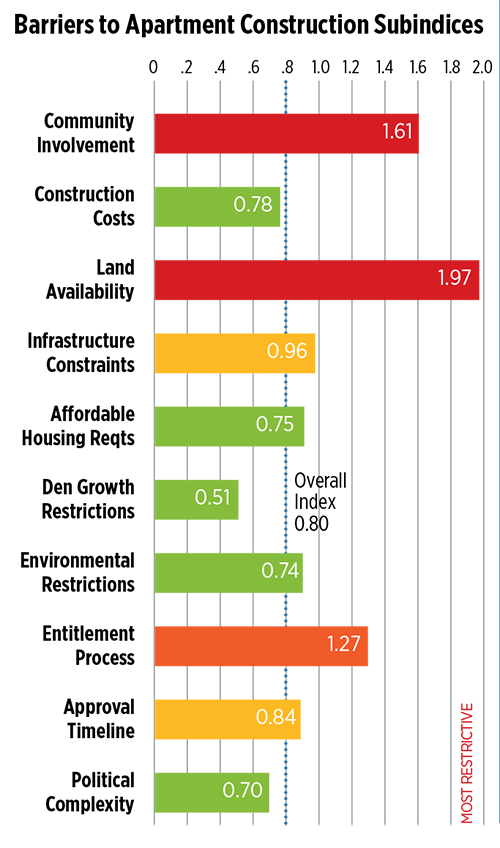 New MF Demand: 8.2k
New MF Demand: 8.2k
High Rent Burden: 47%
Star Share: 36%
Median Rental: $32,020 Household Income
Income Required: $32,320 for Average Rent
Most Restrictive Apartment Categories:
- Land Availability
- Community Involvement
- Entitlement Process
A slower, sprawling housing market, Albuquerque metro is the least restrictive of major markets surveyed but with expected factors ranked high for their impact on apartment development. Respondents cite that land availability and citizen opposition to growth influences the development process the most, with an emphasis on general community opposition and the number of public meetings required. Also noted is the above-index factor of the local entitlement process with mention of lower approval rates that often require a third-party advocate. Median rents rank near bottom of the major markets, though align well with the requirements for the average market rents of $810. This metro housing market expands only westward, as mountains and Native American/government reservations bound its limits. Similar to most major metro markets in this initial Index, these top two issues present formidable relative barriers to new apartment supply amid consistent demand ahead.
Barriers Rankings #7: Cleveland, OH
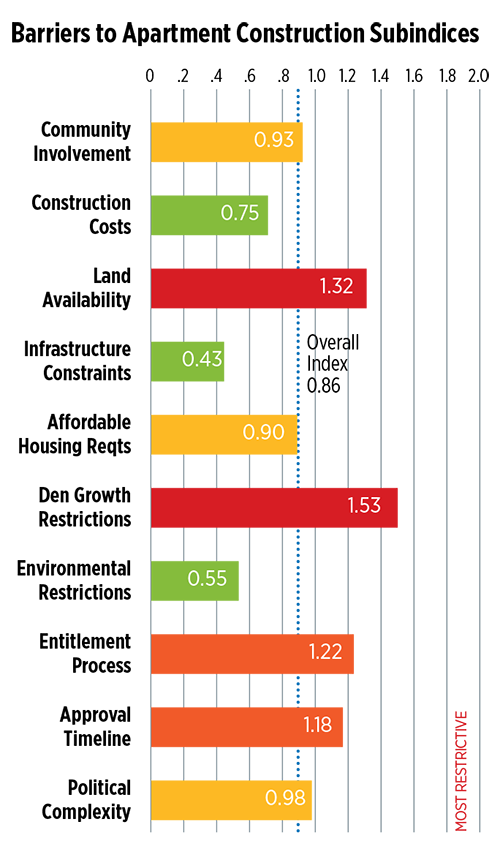 New MF Demand: 4.0k
New MF Demand: 4.0k
High Rent Burden: 45%
Star Share: 46%
Median Rental: $30,250 Household Income
Income Required: $35,200 for Average Rent
Most Restrictive Apartment Categories:
- Density & Growth Restrictions
- Land Availability
The older Cleveland metro ranks better than most major markets on supply barriers with an overall index of 0.86, though overall apartment demand is the lowest of the larger national metros surveyed (Sioux Falls is lower). Respondents cite the expected land availability as most restrictive, mostly on heavy land-use regulations, along with density restrictions driven by height and parking restrictions. Also cited as restrictive are land-use regulations that burden the entitlement process and a generally lengthy approval timeline. Political complexity noted the heavy influence of local councils on the apartment development outcomes. Cleveland posts the lowest median rental incomes of major markets and these incomes are 14% below the requirement for average rents of $880. A significant 46% of metro rental stock is seen as more affordable STAR units found in older, distressed neighborhoods.
Barriers Rankings #9: Chicago, IL
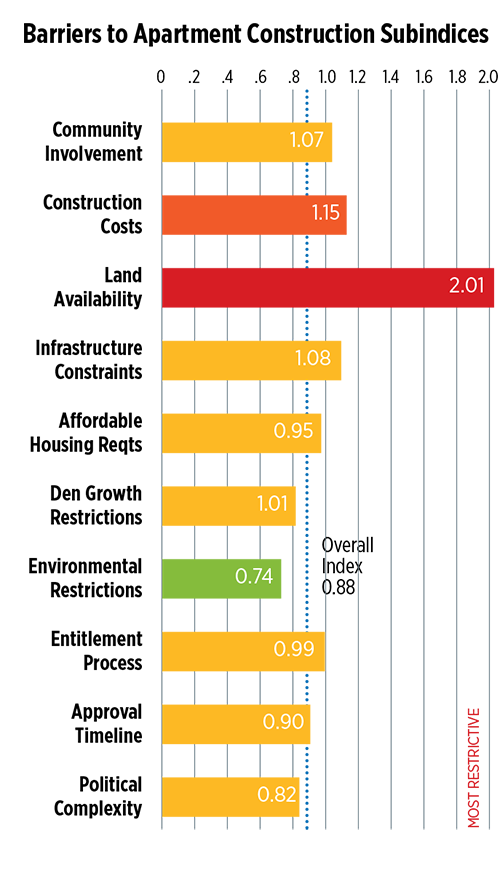 New MF Demand: 35.2k
New MF Demand: 35.2k
High Rent Burden: 44%
Star Share: 39%
Median Rental: $41,130 Household Income
Income Required: $55,160 for Average Rent
Most Restrictive Apartment Categories:
- Land Availability
The sprawling Chicago metro ranks in the top fourth of other major markets for least restrictive supply barriers and an index of 0.88. Most of the subindices below align with the index, save for the glaring restriction of land availability and its suitability for development. Other key issues cited are the number of public meetings needed for community engagement, high impact fees and their waiver, general density restrictions and the heavy influence of local councils. The median metro rental incomes are a significant 25% below the required for average market rents of $1,380. Some 44% of renters pay over 35% of income on their lease. As with scaled metros like Chicago, these barriers become more pronounced in the urban core relative to outlying housing sectors. Affordable housing requirements Downtown drive project values lower and restrict underwriting, while entitlements often are delayed by arbitrary zoning conditions among 50 wards. Development teams also suffer from high property taxes and a lack of confidence in the local fiscal conditions.
Barriers Rankings #10: Dallas, TX
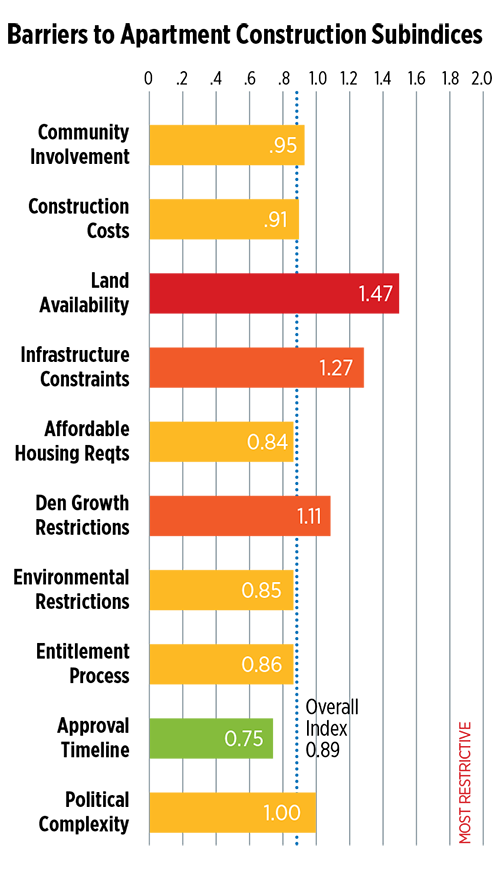 New MF Demand: 227k
New MF Demand: 227k
High Rent Burden: 40%
Star Share: 19%
Median Rental: $45,800 Household Income
Income Required: $44,960 Average Rent
Most Restrictive Apartment Categories:
- Land Availability
- Infrastructure Constraints
- Density & Growth Restrictions
Metro Dallas-Fort Worth enjoys both the greatest apartment demand among major national markets and ranks in the top fourth of lowest barriers to new apartments with an overall supply index of 0.89. Survey respondents in this sprawling metro cite land availability as the greatest restriction. Also cited is infrastructure constraints relative to availability, impact fees and traffic, plus general density restrictions tied to lot, height and parking limits. Above the index, political complexity is specific to the heavy influence of both local councils and their residents. Typical supply restrictions from other community, construction and land costs, affordable housing, environmental and entitlement issues are nominal. The median rental income in Dallas is just above the income requirements for their average market rents of $1,125.
Barriers Rankings #11: Portland, OR
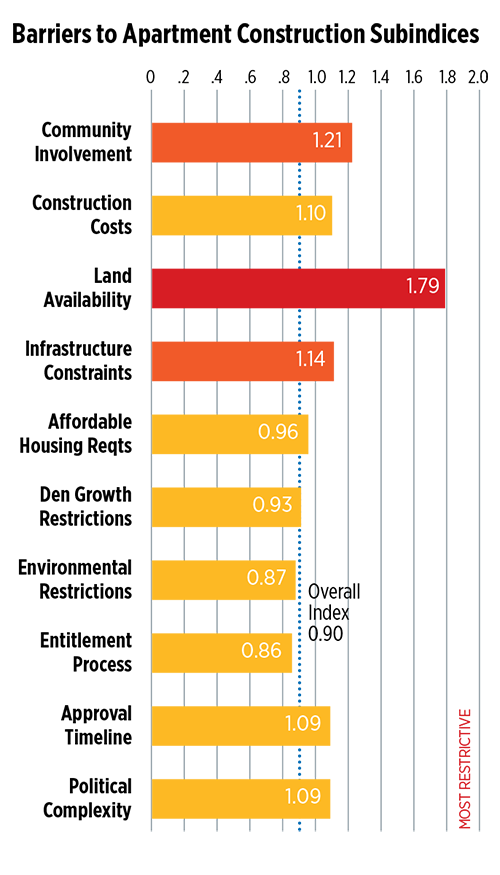 New MF Demand: 36.0k
New MF Demand: 36.0k
High Rent Burden: 43%
Star Share: 37%
Median Rental: $47,440 Household Income
Income Required: $51,160 Average Rent
Most Restrictive Apartment Categories:
- Land Availability
- Community Involvement
Portland metro ranks in the top fourth of least-restrictive major markets with an overall index of 0.90. Demand for new multifamily is ranked near median with national metros. Survey respondents cite land availability and its development feasibility as the top barrier to new apartments, followed by community involvement, specifically the amount of public engagement required and local opposition. Also noted is infrastructure constraints driven by general availability, impact fees and their mitigation, and traffic. Construction costs, approval timelines and political complexity are just above index. Median rental income ranks in the upper third of major markets and is 7.0% below the requirement for average market rents of $1,280.
View The Market Most Resistant To Development
View and Download the Full Report
Definitions and Notes
- BARRIERS RANKING is the relative ranking among 58 major metro apartment markets based on the average index of each metro from the least restricted to the most; ranges from 1 (Albuquerque) to 58 (San Jose). Rankings consider expert responses from throughout the extended metro that includes but not isolates the urban core.
- NEW MF DEMAND is the updated total demand for new multifamily units (in thousands) through 2030 based upon the forecasted total rental housing demand 2017-2030 from the NAA-NMHC demand study by HAS: U.S. Apartment Demand—A Forward Look (2017); ranges from 3,890 (Sioux Falls) to 222,589 (New York).
- HIGH RENT BURDEN refers to that share of 2017 households spending over 35% of combined household income on rent; major metro ranges from 56% and rents of $1,370 (Miami) to 38% and rents of $865 (Sioux Falls) with a major metro average of 43%.
- STAR SHARE is that share of metro rental housing stock with five or more units HAS qualified as Second-Tier Affordable Rentals or those non-institutional sites of typically lower unit count, lower quality and greater age, often overlooked as crucial affordable housing already in place. Using CoStar® ratings of 1-5 for sites of five units or more,
- STAR is the lower ratings of 1-2. This share ranges from 61% (Los Angeles) to 17% (Austin) with a major metro average of 36%.
- INCOME REQUIRED FOR AVERAGE RENT assumes a more conservative 30% of rental household income needed for the average metro contract rent.
